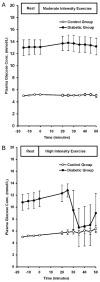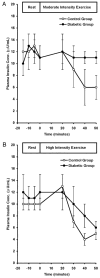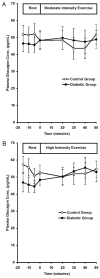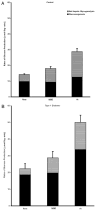Regulation of net hepatic glycogenolysis and gluconeogenesis during exercise: impact of type 1 diabetes
- PMID: 15356077
- PMCID: PMC2995531
- DOI: 10.1210/jc.2004-0408
Regulation of net hepatic glycogenolysis and gluconeogenesis during exercise: impact of type 1 diabetes
Abstract
The effects of type 1 diabetes on the contributions of net hepatic glycogenolysis and gluconeogenesis to glucose production (GP) at rest and during moderate (MOD) and high (HI) intensity running were examined in healthy control (n = 6) and type 1 diabetic (n = 5) subjects matched for age, weight, and maximum aerobic capacity by combined noninvasive measurements of hepatic glycogen content using (13)C nuclear magnetic resonance spectroscopy and determination of GP using [6,6-(2)H(2)]glucose. In the control subjects, GP increased in proportion to the intensity of the exercise [at rest (REST), 14.3 +/- 0.5; MOD, 18.1 +/- 0.9; HI, 28.8 +/- 1.3 micromol/(kg-min); P = 0.001, three-way comparison], and this was accounted for by an increase in the percent contribution of net hepatic glycogenolysis to GP (REST, 32 +/- 1%; MOD, 49 +/- 5%; HI, 57 +/- 5%; P = 0.006). In the diabetic subjects, resting rates of GP were 60% higher than those in the control subjects (P < 0.0001) and increased in proportion to the workload. In contrast, the contributions of net hepatic glycogenolysis to GP were consistently lower than those in the control subjects (REST, 20 +/- 6%; MOD, 32 +/- 13%; HI, 32 +/- 3%; P = 0.006 vs. control), and the exaggerated rates of GP could be entirely accounted for by increased rates of gluconeogenesis. In conclusion, 1) increases in GP in healthy control subjects with exercise intensity can be entirely attributed to increases in net hepatic glycogenolysis. 2) In contrast, moderately controlled type 1 diabetic subjects exhibit increased rates of GP both at rest and during exercise, which can be entirely accounted for by increased gluconeogenesis.
Figures





Similar articles
-
Role of hepatic glycogen breakdown in defective counterregulation of hypoglycemia in intensively treated type 1 diabetes.Diabetes. 2006 Mar;55(3):659-66. doi: 10.2337/diabetes.55.03.06.db05-0849. Diabetes. 2006. PMID: 16505228
-
Contributions of net hepatic glycogenolysis and gluconeogenesis to glucose production in cirrhosis.Am J Physiol. 1999 Mar;276(3):E529-35. doi: 10.1152/ajpendo.1999.276.3.E529. Am J Physiol. 1999. PMID: 10070020
-
Regulation of net hepatic glycogenolysis and gluconeogenesis by epinephrine in humans.Am J Physiol Endocrinol Metab. 2009 Jul;297(1):E231-5. doi: 10.1152/ajpendo.00222.2009. Epub 2009 May 19. Am J Physiol Endocrinol Metab. 2009. PMID: 19458062 Free PMC article. Clinical Trial.
-
Nuclear magnetic resonance studies of hepatic glucose metabolism in humans.Recent Prog Horm Res. 2001;56:219-37. doi: 10.1210/rp.56.1.219. Recent Prog Horm Res. 2001. PMID: 11237214 Review.
-
Gluconeogenesis and glycogenolysis in health and diabetes.J Investig Med. 2004 Sep;52(6):375-8. doi: 10.1136/jim-52-06-31. J Investig Med. 2004. PMID: 15612450 Review.
Cited by
-
Muscle and liver glycogen utilization during prolonged lift and carry exercise: male and female responses.Physiol Rep. 2017 Feb;5(4):e13113. doi: 10.14814/phy2.13113. Epub 2017 Feb 27. Physiol Rep. 2017. PMID: 28242815 Free PMC article.
-
Transient receptor potential vanilloid type 1-dependent regulation of liver-related neurons in the paraventricular nucleus of the hypothalamus diminished in the type 1 diabetic mouse.Diabetes. 2012 Jun;61(6):1381-90. doi: 10.2337/db11-0820. Epub 2012 Apr 9. Diabetes. 2012. PMID: 22492526 Free PMC article.
-
The Effect of High-Intensity Interval Exercise on Short-Term Glycaemic Control, Serum Level of Key Mediator in Hypoxia and Pro-Inflammatory Cytokines in Patients with Type 1 Diabetes-An Exploratory Case Study.Nutrients. 2023 Aug 27;15(17):3749. doi: 10.3390/nu15173749. Nutrients. 2023. PMID: 37686781 Free PMC article.
-
Effect of physical training on metabolic responses of pregnant rats submitted to swimming under thermal stress.J Res Med Sci. 2009 Jul;14(4):223-30. J Res Med Sci. 2009. PMID: 21772888 Free PMC article.
-
An orally available compound suppresses glucagon hypersecretion and normalizes hyperglycemia in type 1 diabetes.JCI Insight. 2024 Jan 23;9(2):e172626. doi: 10.1172/jci.insight.172626. JCI Insight. 2024. PMID: 38258903 Free PMC article.
References
-
- Wahren J. Glucose turnover during exercise in man. Ann NY Acad Sci. 1977;301:45–55. - PubMed
-
- Coggan AR, Swanson SC, Mendenhall LA, Habash DL, Kien CL. Effect of endurance training on hepatic glycogenolysis and gluconeogenesis during prolonged exercise in men. Am J Physiol. 1995;268:E375–E383. - PubMed
-
- Felig P, Wahren J. Fuel homeostasis in exercise. N Engl J Med. 1975;293:1078–1084. - PubMed
-
- Wasserman DH, Williams PE, Lacy DB, Green DR, Cherrington AD. Importance of intrahepatic mechanisms to gluconeogenesis from alanine during exercise and recovery. Am J Physiol. 1988;254:E518–E525. - PubMed
Publication types
MeSH terms
Substances
Grants and funding
LinkOut - more resources
Full Text Sources
Other Literature Sources
Medical

